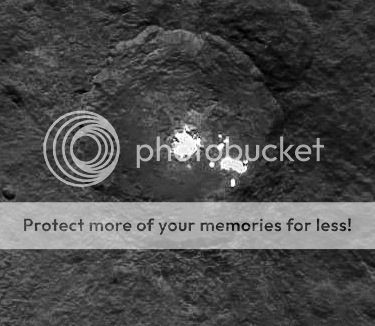It looks like you're using an Ad Blocker.
Please white-list or disable AboveTopSecret.com in your ad-blocking tool.
Thank you.
Some features of ATS will be disabled while you continue to use an ad-blocker.
share:
The JPL released an image of the bright spots today, taken from the newly assumed survey orbit. The resolution is 1400 meters per pixel, the best yet.
A few new details are visible, but the overall shape of the two largest spots persists, one rectangular the other semicircular.
It seems obvious that the overall brightness of the spots is still obscuring their true structure. An image with much less light exposure would very probably be helpful here. This survey orbit will be held for the rest of the month. It's to be hoped that time will be found to take such an image. Link to new image of bright spots, below:
photojournal.jpl.nasa.gov...
It seems obvious that the overall brightness of the spots is still obscuring their true structure. An image with much less light exposure would very probably be helpful here. This survey orbit will be held for the rest of the month. It's to be hoped that time will be found to take such an image. Link to new image of bright spots, below:
photojournal.jpl.nasa.gov...
It's the Tesseract.
The Avengers will be along shortly to pick it up.
The Avengers will be along shortly to pick it up.
a reply to: ScientificRailgun
Don't they have heat/thermal imaging on board of that craft ?
That would answer a few things.
Edit: They do!
Payload :
So why don't they relaese temperature data?
It looks like Nasa wants us to play along.
Don't they have heat/thermal imaging on board of that craft ?
That would answer a few things.
Edit: They do!
Payload :
So why don't they relaese temperature data?
It looks like Nasa wants us to play along.
edit on 10-6-2015 by EartOccupant because: Looked up my own question ; )
a reply to: Ross 54
Do these stop shining when that part of Ceres isnt pointing at the sun?
If they do they must be some kind of crystaline reflective material-olivine maybe(thats common in some moon craters).
If they keep shining when out of direct sunlight,that could be high weirdness..
Do these stop shining when that part of Ceres isnt pointing at the sun?
If they do they must be some kind of crystaline reflective material-olivine maybe(thats common in some moon craters).
If they keep shining when out of direct sunlight,that could be high weirdness..
I see structures an shapes like buildings near the brite areas. I know zooming can cause pixels but...those pixels seem to only form buildings near
the bright spots...hangars?
Would change the world ehh..
Would change the world ehh..
originally posted by: Ross 54
The JPL released an image of the bright spots today, taken from the newly assumed survey orbit. The resolution is 1400 meters per pixel, the best yet. A few new details are visible, but the overall shape of the two largest spots persists, one rectangular the other semicircular.
It seems obvious that the overall brightness of the spots is still obscuring their true structure. An image with much less light exposure would very probably be helpful here. This survey orbit will be held for the rest of the month. It's to be hoped that time will be found to take such an image. Link to new image of bright spots, below:
photojournal.jpl.nasa.gov...
According to this image (below) taken on May 16 from a higher orbit (4500 miles,7200 km) - but less overexposed than this latest image you posted - the larger area on the right that you looks rectangular in your image looks to be at least two smaller circular spots in this less overexposed image, not one rectangular spot.
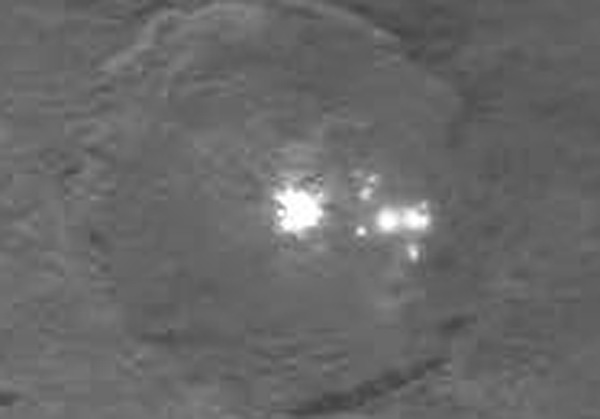
By the way, another image released today shows other areas that are overexposed to the point of looking much like similar "bright spots". I've marked them with arrows in the image below:
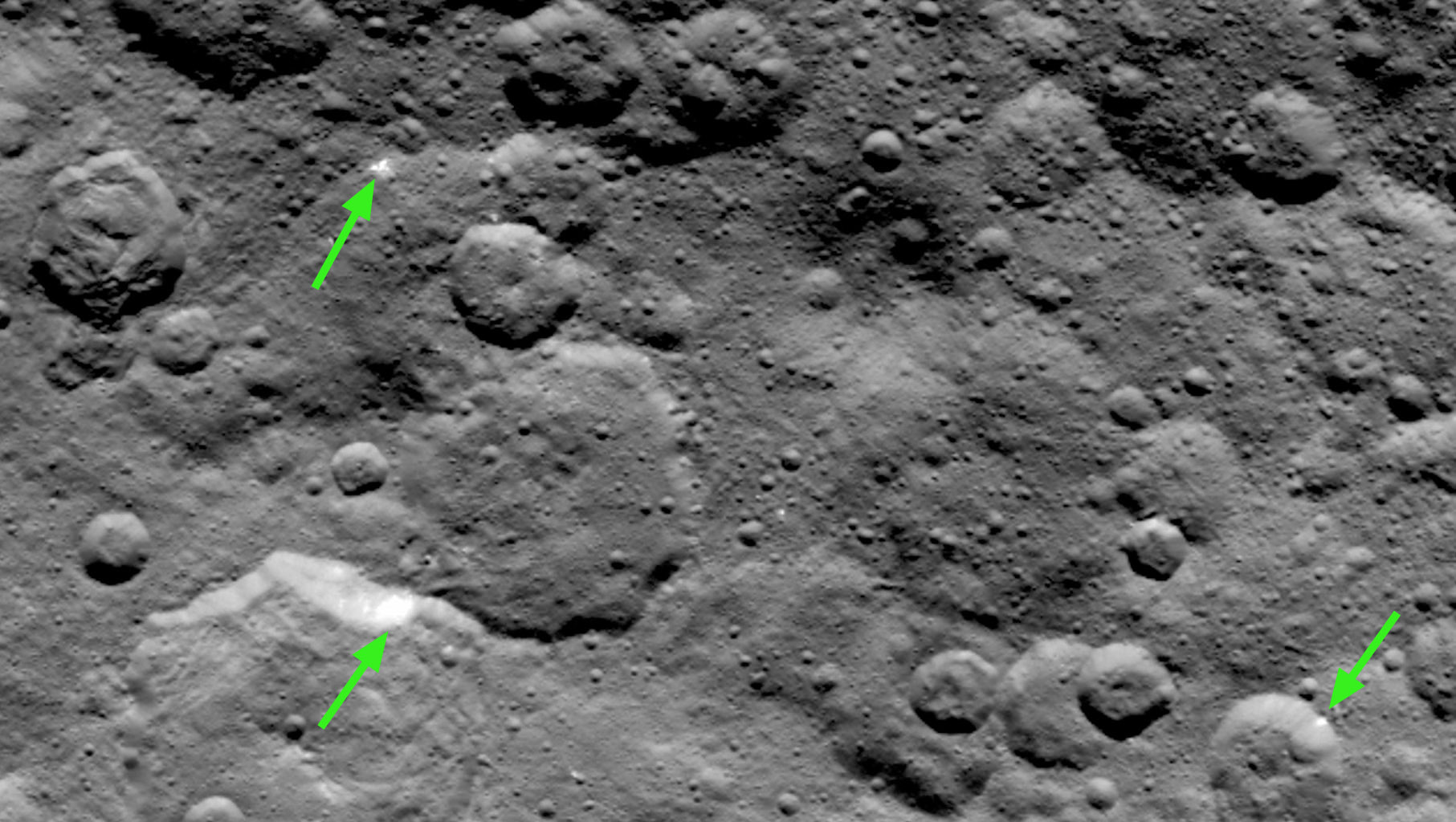
Full image (without arrows):
PIA19570_hires
Edit to update:
Here are cropped enlargements of the other bright spots marked by the arrows on the PIA19570 image above:
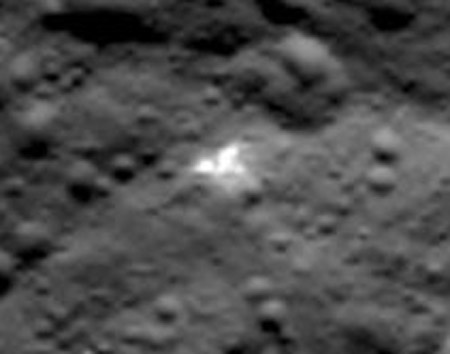
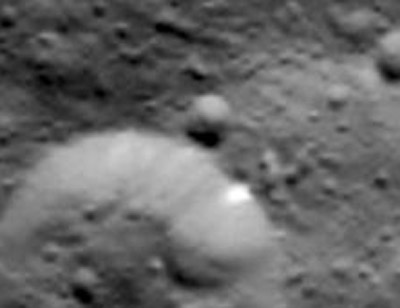
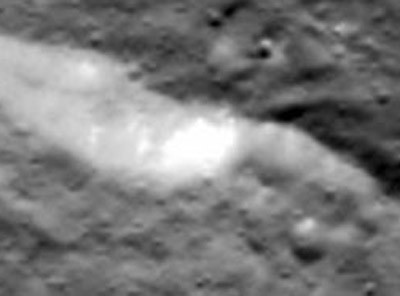
edit on 6/10/2015 by Box of Rain because: (no reason given)
This is how the war of the worlds started
edit on 10-6-2015 by PrinceJohnson because: (no reason given)
a reply to: Ross 54
I started a thread a month ago asking how the spots could even be visible with the constant sprinkling of cosmic dust on celestial bodies. I think the answe must be that these spots are elevated from the crater. My vote is gold or aluminum deposit from the meteor crash.
I started a thread a month ago asking how the spots could even be visible with the constant sprinkling of cosmic dust on celestial bodies. I think the answe must be that these spots are elevated from the crater. My vote is gold or aluminum deposit from the meteor crash.
originally posted by: Ross 54
It seems obvious that the overall brightness of the spots is still obscuring their true structure. An image with much less light exposure would very probably be helpful here.
They most likely already have low-exposure images of the spots, but they're holding on to them for study.
originally posted by: Legman
a reply to: Ross 54
I started a thread a month ago asking how the spots could even be visible with the constant sprinkling of cosmic dust on celestial bodies. I think the answe must be that these spots are elevated from the crater. My vote is gold or aluminum deposit from the meteor crash.
You would think that there is some elevation there, especially at the smaller right-hand spots, (arrowed)

files.abovetopsecret.com...
...... but it can't be seen in the gif.
As it comes into view left to right in the gif there is no frame/s at the terminator, it's just suddenly there in the full view. While it can be seen exiting through the terminator on the right, there is no indication of elevation either.
If the crater with the bright spots was a clock draw a line out from center at about 5:00 outward you will see another tiny bright spot(not as bright)
right on the edge of another circular crater. Zooming in to explore that spot the brightness makes a cross in the center of a square (hate to say it
but it's the only fitting term, though it implies man made, it can also mean natural) structure. It looks like 4 walls enclosing a bright spot. I cant
edit and post it from my mobile so i hope my description is enough to enable you guys to find it as I would like to hear what you guys think. I don't
believe it is pixel related as the square appears early in the zoom, prior to surrounding pixelation's beginning. EDIT: The square is still visable in
Smurfy's image above but no bright cross.
I also noticed an out of place looking black triangle, with some questionable pixel artifact going on. Using the same clock representation from above simply draw the line out from center at about 2:00 and you should see it. It is pretty close to the same distance as the other tiny bright spot i just described, so if you can't see one maybe that will help you find the other. EDIT: Triangle is not visable in Smurfy's image above.
Now that I have thoroughly confused everyone on to the business at hand.
OP, I see the pixel distortions all over the area of the original bright spots. Hard to say if it is camera or processing artifact, or editing. interesting none the less. Thank you!
I also noticed an out of place looking black triangle, with some questionable pixel artifact going on. Using the same clock representation from above simply draw the line out from center at about 2:00 and you should see it. It is pretty close to the same distance as the other tiny bright spot i just described, so if you can't see one maybe that will help you find the other. EDIT: Triangle is not visable in Smurfy's image above.
Now that I have thoroughly confused everyone on to the business at hand.
OP, I see the pixel distortions all over the area of the original bright spots. Hard to say if it is camera or processing artifact, or editing. interesting none the less. Thank you!
edit on 10-6-2015 by wastedown because: (no reason given)
I'm more intrigued now than ever. What's the consensus? Salt? It looks sorta like an impact. Like a sugar meteor hit it,
thanks for posting this.
thanks for posting this.
I'm still sticking to the fact I think it's liquid methane.
One thing I just noticed though is these are not the only spots that appear to be "lighted up". If you look at the original NASA file you can see faint bright spots in multiple areas.
Zoom in to the South of the main area and you can see them
www.nasa.gov...
One thing I just noticed though is these are not the only spots that appear to be "lighted up". If you look at the original NASA file you can see faint bright spots in multiple areas.
Zoom in to the South of the main area and you can see them
www.nasa.gov...
edit on 10-6-2015 by HawkeyeNation because: (no reason
given)
Pools of mercury. I might as well throw in some wild and mostly likely incorrect guess.
originally posted by: canucks555
I'm more intrigued now than ever. What's the consensus? Salt? It looks sorta like an impact. Like a sugar meteor hit it,
thanks for posting this.
Don't forget that most of what you are seeing here is a blob of over-exposed pixels, not the actual bright spot. Some of what we are seeing could be spill-over from the over-exposure.
The actual material that is causing the bright reflection is hidden under those over-exposed pixels.
originally posted by: roadgravel
Pools of mercury. I might as well throw in some wild and mostly likely incorrect guess.
Well, Ceres surface temperature is: -105°C Mercury is a solid at -40°C so if a pool it is a frozen pool.
originally posted by: HawkeyeNation
I'm still sticking to the fact I think it's liquid methane.
One thing I just noticed though is these are not the only spots that appear to be "lighted up". If you look at the original NASA file you can see faint bright spots in multiple areas.
Zoom in to the South of the main area and you can see them
www.nasa.gov...
I posted another image in my post above (also linked below) that also seemed to show some similar, but smaller, bright spots:
www.abovetopsecret.com...
Wouldn't it be funny if it was just some really old garbage an alien ship dumped while passing through?
Humans have a nasty habit of littering wherever we go...
Humans have a nasty habit of littering wherever we go...
I'm glad we have some better images now. Guessing it's a metal deposit of some sort. Not that I have a decent answer, it's a puzzler to be sure.
new topics
-
Cold Blooded Killers on Christmas!! GRRRRrrr!!
Pets: 3 hours ago -
Plane Crash Today --Azerbaijanian E190 passenger jet
Mainstream News: 8 hours ago
top topics
-
Orange County Makes Shoplifting a Felony
Other Current Events: 12 hours ago, 17 flags -
It's Offical Now
US Political Madness: 14 hours ago, 15 flags -
The reason it works is.....
General Chit Chat: 15 hours ago, 8 flags -
Cold Blooded Killers on Christmas!! GRRRRrrr!!
Pets: 3 hours ago, 7 flags -
Plane Crash Today --Azerbaijanian E190 passenger jet
Mainstream News: 8 hours ago, 6 flags
active topics
-
Statements of Intent from Incoming Trump Administration Members - 2025 to 2029.
2024 Elections • 54 • : WeMustCare -
DefCon Teetering on Escalation
World War Three • 51 • : WeMustCare -
-@TH3WH17ERABB17- -Q- ---TIME TO SHOW THE WORLD--- -Part- --44--
Dissecting Disinformation • 3813 • : WeMustCare -
1 Billion dollars
General Entertainment • 13 • : ColeYounger2 -
Cold Blooded Killers on Christmas!! GRRRRrrr!!
Pets • 6 • : rickymouse -
Plane Crash Today --Azerbaijanian E190 passenger jet
Mainstream News • 12 • : rickymouse -
It's Offical Now
US Political Madness • 15 • : Imhere -
Political Warfare & The Resister Special Forces Underground
Political Ideology • 2 • : NoCorruptionAllowed -
London Christmas Market BANS Word ‘Christmas’
Social Issues and Civil Unrest • 49 • : NorthOS -
Post A Funny (T&C Friendly) Pic Part IV: The LOL awakens!
General Chit Chat • 7956 • : KrustyKrab

